Common Mode of Tax Evasion
by Ram Dutt SharmaCONTENTS
| Chapter 1: Introduction | |
| Tax Evasion Meaning | 1 |
| Understanding Tax Evasion with Example | 2 |
| Chapter 2: Existing Legal Provisions and Administrative Machinery to deal with Tax Evasion | |
| [A] Income Tax Act, 1961 | 4 |
| [B] Benami Transactions (Prohibition) Act, 1988 | 5 |
| [C] Foreign Exchange Management Act (FEMA), 2002 | 5 |
| [D) Prevention of Money Laundering Act (PMLA), 2002 | 5 |
| [E) Prevention of Corruption Act & United Nations Convention againstCorruption (UNCAC) | 6 |
| Chapter 3: Tax Evasion - Vulnerable Sectors | |
| (1) Unaccounted Money in the Urban Real Estate Sector | 7 |
| (2) Unaccounted income in the Manufacturing sector | 8 |
| (3) Unaccounted Income in the Indian Securities Markets | 8 |
| (4) Unaccounted income in the Indian Diamond Industry | 9 |
| Chapter 4: Impact of Tax Evasion on the Indian Economy | |
| (i) Revenue loss: | 14 |
| (ii) Inequality and social justice: | 14 |
| (iii) Erosion of trust in institutions: | 15 |
| (iv) Distorted economic incentives: | 15 |
| (v) Underinvestment in public goods: | 15 |
| (vi) Increased tax burden on honest taxpayers: | 15 |
| (vii) Weakened rule of law: | 15 |
| (viii) Encourages Anti-Social Activity: | 15 |
| (ix) Enhance in the Inflation: | 16 |
| (x) Effect on GDP of the country due to less tax collection: | 16 |
| Chapter 5: Difference between Tax Planning, Tax Avoidance and Tax Evasion | |
| General Anti-Avoidance Rules (GAAR) | 19 |
| Difference between tax planning, Tax evasion And Tax avoidance | 21 |
| Chapter 6: Different ways of Tax Evasion occurs | |
| [1] Underreporting of income | 23 |
| [2] Non-payment of due taxes | 23 |
| [3] Smuggling to save different taxes | 24 |
| [4] Submit incorrect tax returns | 24 |
| [5] Out of Book Transactions | 24 |
| [6] Manipulations of Book of Accounts | 25 |
| [7] Maintaining fake financial statements | 25 |
| [8] Financial Market Transactions: | 25 |
| [9] Shell companies and Trusts/ nominees | 25 |
| [10] Land and Real Estate Transactions: | 25 |
| [11] Hiding Money or Assets in Offshore Accounts (Keep money outside India) | 26 |
| [12] Tax Havens countries | 26 |
| [13] Transfer pricing manipulation | 26 |
| [14] Manipulation by through their subsidiary companies | 27 |
| [15] Using Fake documents to claim exemption | 27 |
| [16] False invoicing and billing | 27 |
| [17] Over-Invoicing’ and ‘Under-Invoicing’ of Goods and Services: | 27 |
| [18] Tax evasion through bogus transactions | 28 |
| [19] Misuse of tax treaties | 28 |
| [20] Non-profit Sector: | 28 |
| [21] Illegal Activities and Money Laundering: | 28 |
| Chapter 7: Manipulations of Books of Account for Tax Evasion | |
| Manipulations of Accounts for Tax Evasion | 29 |
| Out of books transactions | 30 |
| Parallel Books of accounts | 30 |
| Chapter 8: Tax Evasion using Agricultural Income & Land | |
| Exemption as a tool of tax evasion and money laundering | 35 |
| Numerous official reports have highlighted the misuse of agricultural income tax exemption for decades | 35 |
| Tax Evasion by Rich Farmers [Lok Sabha Unstarred Question No. 375] | 38 |
| Legal position of Tax on Agriculture | 39 |
| Taxes on agricultural income falls under Entry 46 in “State List� under the Constitution of India | 39 |
| Legislative position of agriculture and agricultural income | 39 |
| Legal framework | 40 |
| Agricultural Income & Its Tax Treatment | 40 |
| Objective of the Department | 41 |
| Chapter 9: Tax Evasion - Gems & Jewellery Sector | |
| What is gems and jewelry? | 66 |
| Structure of the Industry | 66 |
| Liberalization of the Indian economy in 1991 | 67 |
| Major Hubs for Gems and Jewellery | 68 |
| Sources of information on this trade for purposes of investigations | 69 |
| Co-ordination between ITD and other Government agencies | 69 |
| Factors that affect the profit margin in the gold jewellery business: | 71 |
| Profit margins and ratio analysis | 76 |
| Assessee did not furnish any explanation for a sharp decline in gross profit rate from 11.7 per cent in immediately preceding year to only 5.99 per cent in assessment year under consideration,Assessing Officer was justified in making flat addition at 5 per cent of disclosed sales | 125 |
| Chapter 10: Tax Evasion in the Real Estate Sector | |
| Effect on Land Prices | 127 |
| Recommendations of Various Committees for Specific Legislative Measures | 128 |
| Emergence of RERA and understanding its certain concepts | 134 |
| Chapter 11: Tax Evasion through Penny Stocks | |
| What are penny stocks? | 193 |
| Results of Kolkata Investigations [Investigation Report of the Directorate of Income Tax (Investigation) Kolkata, in case of Project Bogus LTCG through BSE Listed Penny Stocks] | 194 |
| SEBI Investigation and ban | 195 |
| Types of penny stock companies | 195 |
| Method of Transaction | 195 |
| Modus operandi as per Investigation report | 197 |
| Bogus capital gains from Penny stocks | 200 |
| Chapter 12: Tax Evasion through Share Premium | |
| Objective of the amendment to section 56(2)(viib) | 248 |
| Extract of object Memorandum of Finance Bill, 2012 | 249 |
| Applicability of clause (viib) to section 56(2) | 252 |
| Chapter 13: Tax Evasion in garb of Share Application Money | |
| Share application money pending for allotment of shares | 314 |
| Checklist for Verification | 314 |
| Chapter 14: Tax Evasion - Income earned in providing the Accommodation Entries | |
| What is accommodation entry? | 320 |
| As per the “Report of the DIT (Investigation), Kolkata - Modus operandi in brief | 322 |
| Role of Income Tax Department | 323 |
| Suggestive questionnaire for Assessing Officer to make investigation while dealing with Accommodation entry issues | 323 |
| Chapter 15: Tax Evasion through Shell Companies | |
| What is shell company | 350 |
| How does a Shell company operate in India? | 351 |
| Modus operandi | 352 |
| The checklist should interalia include | 353 |
| Chapter 16: Tax Evasion through Client Code Modification | |
| What is Client Code Modification (CCM) | 362 |
| Purpose of Client Code Modification (CCM) | 363 |
| Misuse to evade taxes | 363 |
| Policy for Client Code Modification | 363 |
| Chapter 17: Tax Evasion through Options Trades | |
| What is options trading? | 394 |
| Types of Options Trading | 394 |
| Modus operandi | 394 |
| Familiar script | 395 |
| Chapter 18: Tax Evasion through Payment of On-Money for Purchase of Property | |
| What is On-money | 397 |
| Tax evasion through understatement of the value of properties | 398 |
| Chapter 19: Tax Evasion through Bogus Transactions | |
| Role of Income Tax Department | 411 |
| Bogus transactions | 411 |
| Bogus transaction under Income Tax Act | 412 |
| Burden of proof | 412 |
| Type of additions seen made in different cases of assessee | 413 |
| Chapter 20: Use of Tax Haven Countries for Tax Evasion | |
| Modus operandi | 432 |
| Tax Free Crypto Countries | 432 |
| Chapter 21: Tax Evasion through Cryptocurrencies | |
| What is Crypto Tax Evasion? | 434 |
| There are two kinds of crypto tax evasion: | 435 |
| Techniques used for Cryptocurrency Tax Evasion | 435 |
| Existing guidance on crypto taxes from the Income Tax Department | 437 |
| Penalties for crypto tax evasion in India | 437 |
| Chapter 22: Provisions to Check Tax Evasion | |
| Aggregate Payment has to be seen | 441 |
| Limit for disallowance of expenditure made otherwise than by an account payee cheque or account payee bank draft | 442 |
| Burden of proof | 442 |
| Chapter 23: Penalty for Tax Evasion under Taxation Law | |
| Overview of Section 270A | 499 |
| Difference between underreporting and misreporting of income | 499 |
| Applicability of section 271AAB | 499 |
| False entries for the purpose of penalty under section 271AAD | 508 |
| Chapter 24: Prosecution for Tax Evasion under Taxation Law | |
| The term “willful� | 515 |
| What is an “Attempt�? | 515 |
| The word ‘evade’ | 515 |
| Evasion of tax | 516 |
About the Author
Ram Dutt Sharma
Ram Dutt Sharma was born on 27th June, 1958 in Narnaul, Haryana. He got his post-graduation from M.D. University, Rohtak in 1980. He joined the Income-tax Department in the year 1983 and retired as Income Tax Officer on 30.06.2018. He worked at various stations of North-West Region of Income-tax Department. He has wide experience of all wings of Income-tax Department such as Assessment Unit, Special Range, TDS Wing, Investigation Wing, etc. He has been Contributing articles and addressing on topics relating to Income Tax at NADT Regional Campus, Chandigarh & Bhopal. He has also addressed number of seminars organized by the Income-tax Department, Chartered Accountants, Advocates and various Trade Associations.
He is recipient of first-ever Finance Minister's Award 2017, the Income Tax Departments highest honour for sustained devotion, commitment to duty & promoting excellence in the field of Direct Taxation at National Level. The Hon'ble Union Finance Minister, Shri ArunJaitley conferred this Finance Ministers Award for Excellence for his meritorious services at VigyanBhawan, New Delhi on 24.07.2017.
Awarded by Hon'ble Member (Revenue& TPS), CBT, Special Secretary to the Government of India Certificate of Appreciation for his contribution recognized and included in the chapter Miscellaneous Orders in Let Us Share A compilation of Best Practices & Orders Vol. VIII released on 31stOctober, 2016.
Have Questions About This Book?
Our course advisors are here to help you make the right decision for your career growth.
Other books
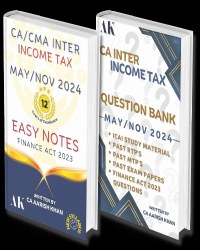
CA/CMA INTER COMBO - COLOURED EASY NOTES + QUESTION BANK
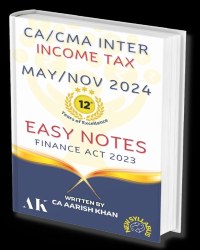
CA/CMA INTER EASY NOTES COLOURED
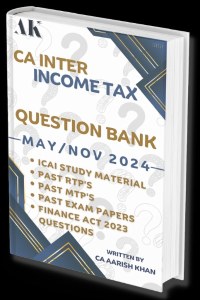
CA/CMA INTER INCOME TAX QUESTION BANK

GST (IDT) Book - 4th Edition | May, Sept 2026 & Jan 2027 Attempt
List your Books
Share your knowledge and help shape the next generation of tech-savvy CA & Tax professionals while building a rewarding career in education.
Get Started

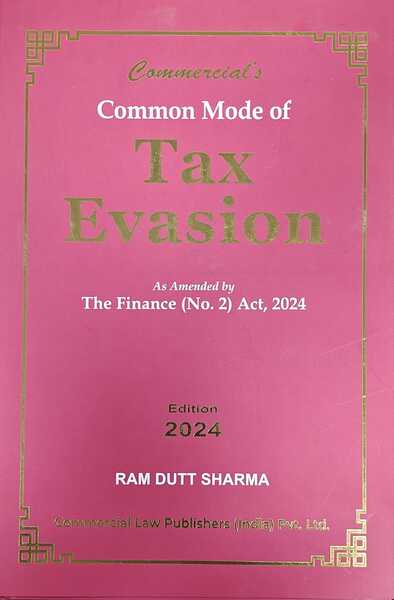
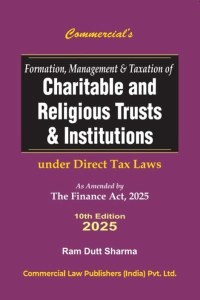
 CAclubindia
CAclubindia
